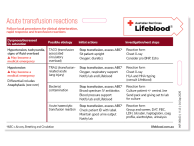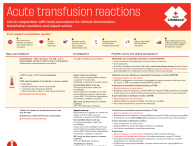Don’t have an account?
Select the donation type you’d like to make
When to suspect this adverse reaction
Patients present with an unexpected temperature rise (≥38 °C or isolated rise 1 °C to <1.5 °C above the pretransfusion value) during or within 4 hours of transfusion. This is usually an isolated finding in mild febrile non-haemolytic transfusion reactions (FNHTR) without other signs or symptoms.
A moderate to severe FNHTR should be considered with a temperature of ≥ 39 °C or rise of ≥ 1.5 °C above baseline, OR other signs/symptoms such as: chills/rigors, increased respiratory rate, change in blood pressure, anxiety, localised pain, and nausea/vomiting.
However, it’s important to refer to your local hospital policies and guidelines for recognition and initial management of adverse transfusion reactions as reporting requirements may vary based on the severity of reactions and definitions for signs and symptoms (e.g. threshold temperature or by how much it has risen can vary).
It is also important to note that these symptoms may also occur in other, more serious transfusion reactions, with the most serious being, acute haemolytic reactions, transfusion transmitted bacterial infection (TTBI) and transfusion-related acute lung injury (TRALI).
FNHTR is a diagnosis of exclusion.
Occur in 0.1% to 1% of transfusions (with universal leucocyte depletion).
Usual causes
Cytokines accumulating during storage of cellular components (especially in platelet units) is thought to be the most common cause of FNHTRs. Cytokines are released by white cells, the occurence of which is reduced by pre-storage leucodepletion.
Febrile reactions may also be caused by leucocyte antibodies in the recipient, formed following transfusion or pregnancy. These antibodies react with human leucocyte antigens (HLA) or other antigens found on donor lymphocytes, granulocytes, or platelets.
What to do
STOP the transfusion immediately and follow the steps for managing a suspected transfusion reaction.
Clinically assess the patient for fever, chills, rigors and headache.
Treat the fever with an antipyretic. However, avoid aspirin in thrombocytopenic and paediatric patients.
Consider and exclude other causes, as fever alone may be the first manifestation of a life-threatening reaction.
Rule out an acute haemolytic reaction, TTBI and transfusion-related acute lung injury (TRALI).
If other causes of a fever have been excluded and the patient is otherwise well with stable observations, it is possible to restart the transfusion at a slow rate, with appropriate observation of the patient.
Investigation
Exclude an acute haemolytic reaction, TTBI or TRALI. No further investigation is required for a mild FNHTR where a serious or severe reaction has been ruled out.
For moderate to severe reactions:
- Exclude incompatibility:
- Clerical checks to confirm ABO types of patient and transfused product;
- Perform a blood group and antibody screen, and direct antiglobulin test (DAT) on pre- and post-transfusion specimens.
- A haemolysis screen (FBC, LDH, bilirubin, haptoglobin, electrolytes, creatinine, urinalysis) may be indicated if an acute haemolytic reaction is suspected.
- DIC work-up (aPTT, PT, fibrinogen, D-Dimer).
- Consider investigations for transfusion-associated sepsis with blood cultures on both the patient and implicated product.
- In patients with repeated severe FNHTRs, investigation for HLA antibodies may be useful.
Updated September 2025




